-
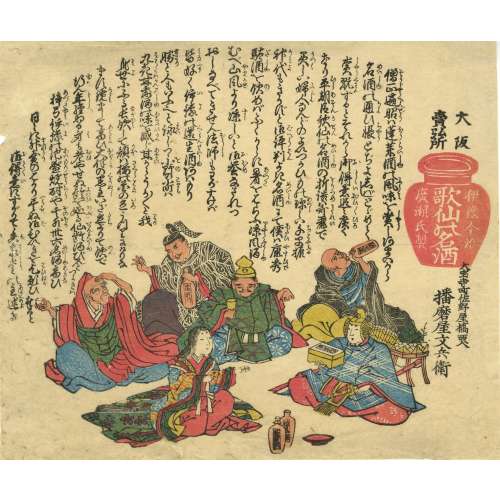 An uncut fan print uchiwa-e, size 22.7 x 28.7cm, by an unknown artist.
An uncut fan print uchiwa-e, size 22.7 x 28.7cm, by an unknown artist. -
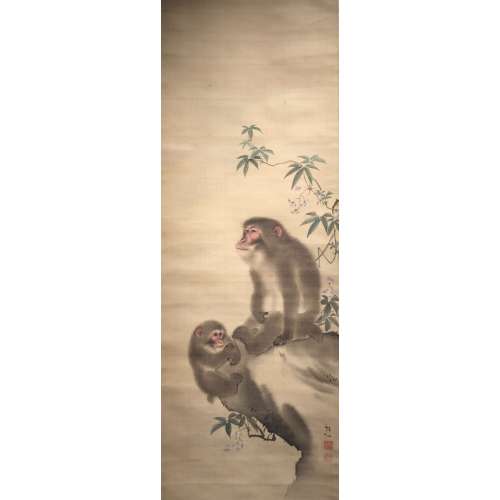 Mori Sosen (1747-1821). A Monkey Seated on a Rock with an Infant Monkey. Hanging scroll painting. Ink and colour on silk. Signed: Sosen. Sealed: Sosen. 108.3 x 38.3 cm. Provenance: According to the box inscriptions, the painting was in the possession of Itakura Katsunao, a daimyo lord in present-day Gunma, in 1808. In 1881, the painting was subsequently acquired by Negishi Shôrei (1833-1897) a master swordsman who established the Negishi school of shuriken ("The only specialist school to have survived is the Negishi-ryū, which was founded by Negishi Shorei in the mid-1800s".)
Mori Sosen (1747-1821). A Monkey Seated on a Rock with an Infant Monkey. Hanging scroll painting. Ink and colour on silk. Signed: Sosen. Sealed: Sosen. 108.3 x 38.3 cm. Provenance: According to the box inscriptions, the painting was in the possession of Itakura Katsunao, a daimyo lord in present-day Gunma, in 1808. In 1881, the painting was subsequently acquired by Negishi Shôrei (1833-1897) a master swordsman who established the Negishi school of shuriken ("The only specialist school to have survived is the Negishi-ryū, which was founded by Negishi Shorei in the mid-1800s".) -
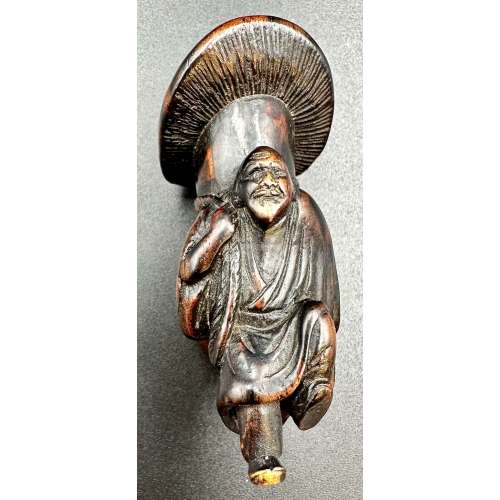 NEW
NEWNetsuke with a design of an old man carrying a giant mushroom on his back. Possibly signed on his left foot. According to Merrily Baird (Symbols of Japan, page. 93): ... This prominent use in the symbol-rich netsuke art form, however, reflects more their sexual symbolism than either their dietary appeal or interesting shapes. Mushrooms in Japan are generally a symbol of fertility, with some flat varieties, like shiitake, being associated with females. In contrast, the matsutake mushroom (Armillaria edodes) is a phallic symbol, as befits its thick, spearlike stem and the fact that it is consumed before cap opens.
Seller's description: "The old man carved walking, with one foot slightly raised, wearing a loose fitted robe and carrying a large long-stemmed mushroom on his back. The wood stained and bearing a fine patina. Himotoshi through the mushroom stem". See VO-0270.2018 for the same subject. Late 18th century. Dimensions: 62 mm tall -
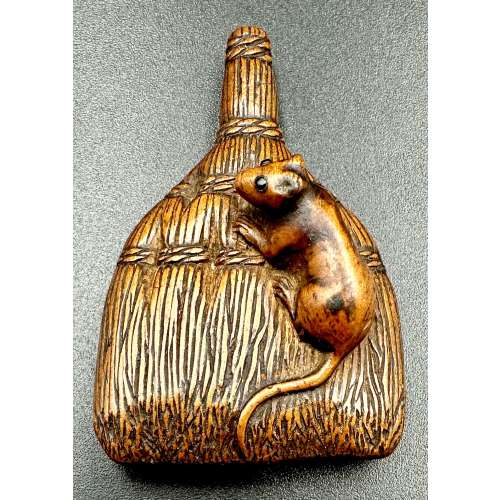 NEWFinely carved as a rat (nezumi) seated on a shuro brush, bound naturalistically with thick bristles. The rodent with a long trailing tail and eyes inlaid in a dark horn. Generously excavated, asymmetrical himotoshi to the underside. According to Merrily Baird (Symbols of Japan, p. 156): …The Japanese do not clearly differentiate between the rat and the mouse, and one word, nezumi [鼠], designates both. …Rat is a messenger of Daikokuten, a deity of grain and vegetation who is one of Japan’s Seven Gods of Good Luck. ...Depictions of the rat are most common in years of the zodiac represented by the animal. Late 18th century. Dimensions: 49 x 33 x 16 mm. Provenance: From the private collection of Armand Basi (Spanish, 1924-2009).
NEWFinely carved as a rat (nezumi) seated on a shuro brush, bound naturalistically with thick bristles. The rodent with a long trailing tail and eyes inlaid in a dark horn. Generously excavated, asymmetrical himotoshi to the underside. According to Merrily Baird (Symbols of Japan, p. 156): …The Japanese do not clearly differentiate between the rat and the mouse, and one word, nezumi [鼠], designates both. …Rat is a messenger of Daikokuten, a deity of grain and vegetation who is one of Japan’s Seven Gods of Good Luck. ...Depictions of the rat are most common in years of the zodiac represented by the animal. Late 18th century. Dimensions: 49 x 33 x 16 mm. Provenance: From the private collection of Armand Basi (Spanish, 1924-2009). -
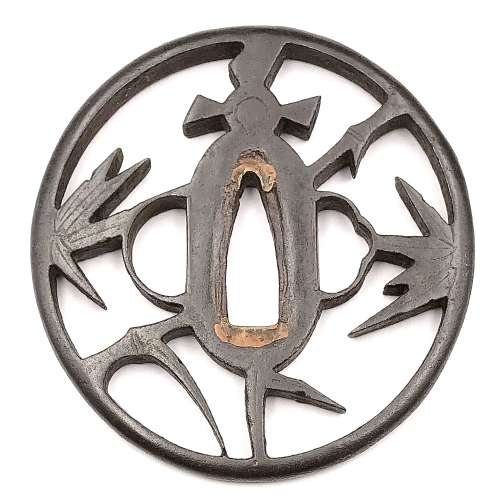 Iron tsuba with design of bamboo and sparrow (take-ni-suzume) in openwork (sukashi). Rounded rim. Copper sekigane. Akasaka school. Unsigned. Attributed to second generation Tadamasa Shōzaemon (died in in the fifth year of Enppo, 1677). Early Edo period: 17th century (Kan-ei / Kanbun era). Height: 79.0 mm. Width: 77.5 mm. Rim thickness: 5.5 mm. Center thickness: 6.6 mm. Provenance: Sasano Masayuki Collection, № 222: "It is believed that sparrows nest in a bamboo grove". According to Merrily Baird [Merrily Baird. Symbols of Japan. Thematic motifs in art and design. Rizzoli international publications, Inc., 2001], "a bamboo grove is said to be emblematic of security as the bamboo is resilient even in the face of high winds and heavy rains. [...] The association of the sparrow (suzume) with bamboo is an old one found in Japanese poetry, paining, and design. The bird is said to be obsessed with its honor, especially the repaying of debts".
Iron tsuba with design of bamboo and sparrow (take-ni-suzume) in openwork (sukashi). Rounded rim. Copper sekigane. Akasaka school. Unsigned. Attributed to second generation Tadamasa Shōzaemon (died in in the fifth year of Enppo, 1677). Early Edo period: 17th century (Kan-ei / Kanbun era). Height: 79.0 mm. Width: 77.5 mm. Rim thickness: 5.5 mm. Center thickness: 6.6 mm. Provenance: Sasano Masayuki Collection, № 222: "It is believed that sparrows nest in a bamboo grove". According to Merrily Baird [Merrily Baird. Symbols of Japan. Thematic motifs in art and design. Rizzoli international publications, Inc., 2001], "a bamboo grove is said to be emblematic of security as the bamboo is resilient even in the face of high winds and heavy rains. [...] The association of the sparrow (suzume) with bamboo is an old one found in Japanese poetry, paining, and design. The bird is said to be obsessed with its honor, especially the repaying of debts". -
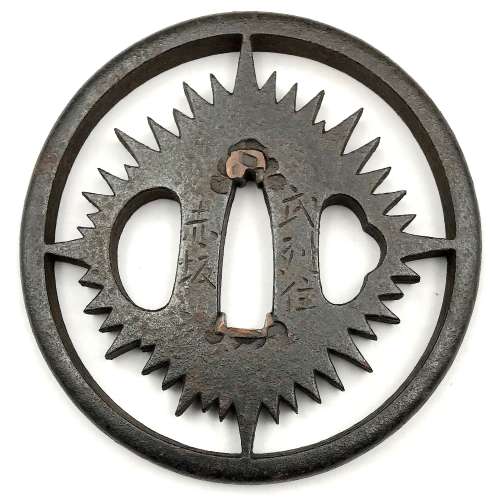 Iron tsuba of round form with slanting rays of light (shakoh) Christian motif (Jesuit’s IHS symbol) in openwork (sukashi). Traditional description of this kind of design is called “tokei”, or “clock gear”. Signed: On the face: Bushu ju Akasaka; On the back: Tadatoki Saku [Made by Tadatoki, resident of Bushu]. Probably, 4th generation of Akasaka School master Tadatoki (忠時), who died in 1746. Akasaka School. Edo period, first half of the 18th century. Size: 79.8 x 78.5 x 6.5 mm
Iron tsuba of round form with slanting rays of light (shakoh) Christian motif (Jesuit’s IHS symbol) in openwork (sukashi). Traditional description of this kind of design is called “tokei”, or “clock gear”. Signed: On the face: Bushu ju Akasaka; On the back: Tadatoki Saku [Made by Tadatoki, resident of Bushu]. Probably, 4th generation of Akasaka School master Tadatoki (忠時), who died in 1746. Akasaka School. Edo period, first half of the 18th century. Size: 79.8 x 78.5 x 6.5 mm -
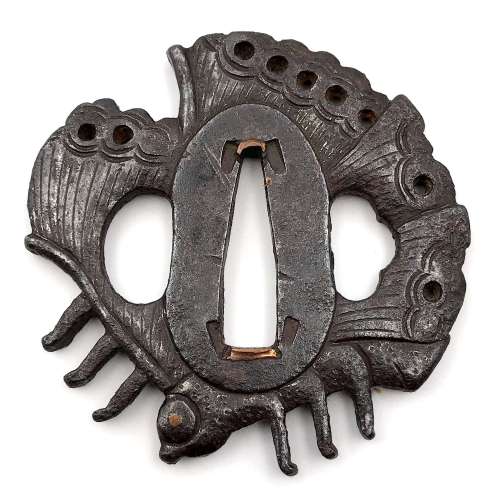 This tsuba is a cut from a typical Bizen Shōami butterfly tsuba (see TSU-0100 in this collection), which normally would have had a circular rim around the butterfly. In this particular example of altered guard we have both eyes of the insect (inlaid in brass or copper) intact. The kebori carving is more pronounced than in TSU-0100 example. Copper sekigane. Unsigned. Attributed to Bizen Shōami school, early Edo period (17th century). Dimensions: 64.7 x 63.7 x 5.2 mm References: see TSU-0100.
This tsuba is a cut from a typical Bizen Shōami butterfly tsuba (see TSU-0100 in this collection), which normally would have had a circular rim around the butterfly. In this particular example of altered guard we have both eyes of the insect (inlaid in brass or copper) intact. The kebori carving is more pronounced than in TSU-0100 example. Copper sekigane. Unsigned. Attributed to Bizen Shōami school, early Edo period (17th century). Dimensions: 64.7 x 63.7 x 5.2 mm References: see TSU-0100. -
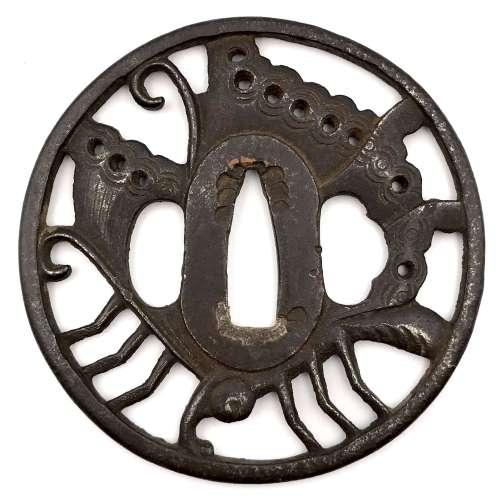 Iron tsuba of round form decorated with the design of a butterfly in openwork (sukashi) with details carved in kebori. Eyes inlaid in brass (one inlay is missing). Unsigned. Attributed to Bizen Shōami school, early Edo period (17th century). Dimensions: 80.4 x 80.6 x 4.4 mm References At Haynes Catalog #6, p. 18-19, Lot 30: "Famous Ikeda butterfly design" (Ikeda family of Inaba and Okayama, and at least 7 other families). Ca. 1700. Shōami of Kyoto, no doubt. Ht 8.2 cm, Th. 5 mm. ["Important tsuba, menuki, bokuto, woodblock prints, koshirae, sword pistol and kana mono". San Francisco, June 1-26, 1983. Catalog #6. Robert E. Haynes, Ltd.]Similar tsuba at Haynes Catalog #9, p.71, lot 143: the classic Shoami tsuba of the mon of the Ikeda family. This example, as most, seems to be made by the same hand as the others. See Haynes sale number 6, lot 30, for an identical example. The eye is brass. From an old French collection. Ht. 7.9 cm., Th. 5 mm.
Iron tsuba of round form decorated with the design of a butterfly in openwork (sukashi) with details carved in kebori. Eyes inlaid in brass (one inlay is missing). Unsigned. Attributed to Bizen Shōami school, early Edo period (17th century). Dimensions: 80.4 x 80.6 x 4.4 mm References At Haynes Catalog #6, p. 18-19, Lot 30: "Famous Ikeda butterfly design" (Ikeda family of Inaba and Okayama, and at least 7 other families). Ca. 1700. Shōami of Kyoto, no doubt. Ht 8.2 cm, Th. 5 mm. ["Important tsuba, menuki, bokuto, woodblock prints, koshirae, sword pistol and kana mono". San Francisco, June 1-26, 1983. Catalog #6. Robert E. Haynes, Ltd.]Similar tsuba at Haynes Catalog #9, p.71, lot 143: the classic Shoami tsuba of the mon of the Ikeda family. This example, as most, seems to be made by the same hand as the others. See Haynes sale number 6, lot 30, for an identical example. The eye is brass. From an old French collection. Ht. 7.9 cm., Th. 5 mm.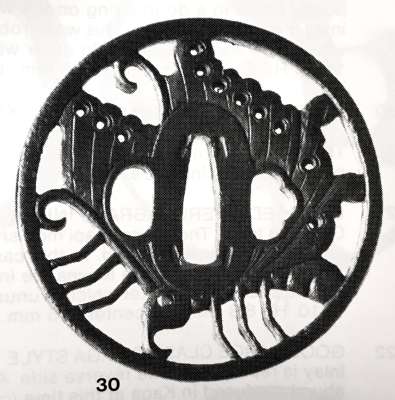
Haynes Catalog #6, lot 30.
Similar tsuba in the Randolph B. Caldwell Collection, 1994, page 24, №13: "A circular iron tsuba pierced in positive sukashi with a butterfly within an angular rim, details engraved. The eye inlaid in brass [in my specimen the inlay is missing on the omote side]. Unsigned. Bizen Shōami, Momoyama period. Dimensions: 8.0 x 8.2 x 0.5 cm. Similar example: Durand-Ruel, collection Ch. Gilloz, number 1302. [SV: that's possibly the 'old French collection' of Robert Haynes.]
Haynes Catalog #9, lot 143.
If we accept Haynes' theory regarding the genealogy and history of Bizen Shōami family, Momoyama period attribution would seem unlikely. I am leaning towards the early to mid 17th century.
Caldwell Collection, #13.
-
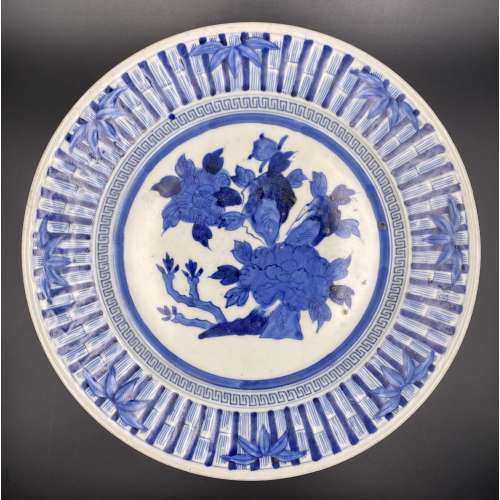 Underglaze cobalt blue and white porcelain plate decorated with a bamboo border, key fret above the blue ring, and a bush of chrysanthemums in the centre. The bottom is decorated with stylized clouds and flowers, a border of lotus petals and signed with a general mark in the centre. Diameter: 29.5 cm; Height: 3.5 cm.
Underglaze cobalt blue and white porcelain plate decorated with a bamboo border, key fret above the blue ring, and a bush of chrysanthemums in the centre. The bottom is decorated with stylized clouds and flowers, a border of lotus petals and signed with a general mark in the centre. Diameter: 29.5 cm; Height: 3.5 cm. -
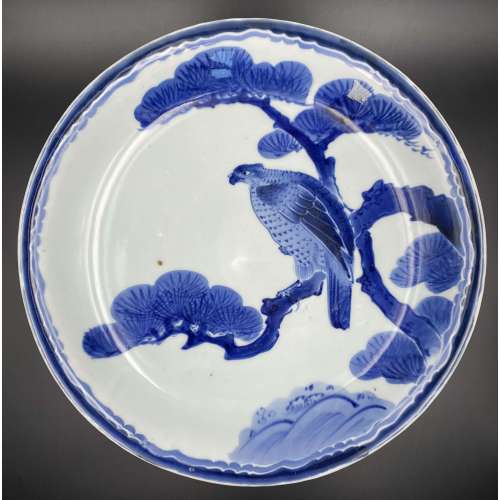 Underglaze cobalt blue and white porcelain plate decorated with a falcon on a pine tree and rough waves beneath; rim with a stylized wave design; seven spur marks on the reverse. Diameter: 31 cm; Height: 5 cm; Diameter of the foot: 18 cm.
Underglaze cobalt blue and white porcelain plate decorated with a falcon on a pine tree and rough waves beneath; rim with a stylized wave design; seven spur marks on the reverse. Diameter: 31 cm; Height: 5 cm; Diameter of the foot: 18 cm. -

Bronze tsuba of mokkō form with narrow slightly raised rim carved in kebori with the sea weed and inlaid with a lobster (ebi) made of copper on the face and two sea shells made of shakudo on the back. Lobster's antennae inlaid in gold, and eyes inlaid in shakudo. Ishime-ji treated surface.
Unsigned.
Late Edo period (mid-19th century). Dimensions: 76.3 x 71.1 x 3.7 mm -
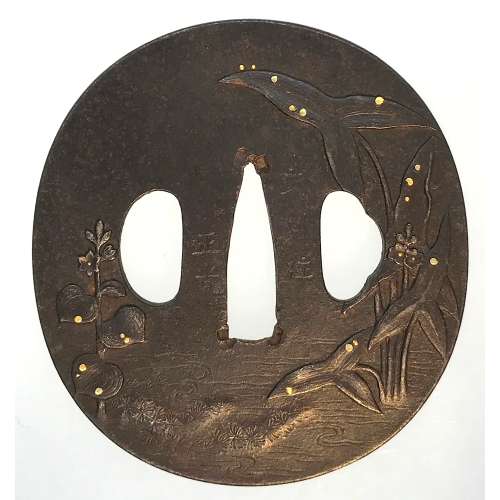
An iron tsuba of oval form decorated with a water plantain (omodaka) carved in low relief and water drops inlaid in gold.
Signed: Bushū jū Masamitsu.
Bushū-Itō school.Height: 71.8; Width: 67.3; Thickness: 3.6; Weight: 96 g.
Mid to late Edo period; 18th-19th century.
There were several tsuba artists with the name of Masamitsu. The one who worked with iron and spelled [正光] is mentioned at Markus Sesko's 'Genealogies' on page 106 in Akasaka School of Edo section as Masamitsu Gorōbei , student of Tadatoki, 4th generation Akasaka master. The name is not mentioned at Torigoye/Haynes 'Tsuba. An Aesthetic Study' in the list of Bushū-Itō family masters on page 181. -
 Woodblock print album of thirteen prints, ōban, nishiki-e. Artist: Chōkyōsai Eiri [鳥橋斎 栄里] (Japanese, fl. c. 1789 ~ 1801 ). Models of calligraphy (Fumi no kiyogaki), New Year 1801. This title is taken from Chris Uhlenbeck's Japanese Erotic Fantasies Sexual Imagery of the Edo Period. — Hotei Publishing, 2005, ISBN 90-74822-66-5):. A detailed description of the album can be found at The Complete Ukiyo-e Shunga №9 Eiri, 1996, ISBN 4-309-91019. Most of the edition is in Japanese, though Richard Lane writes a section in English: Eiri: Love-letters, Love Consummated: Fumi-no-kiyogaki. The article starts with the following statement: "Why all the fuss about Sharaku? Because he is so "mysterious"? No, not at all: because he is such a good artist. But Sharaku is not the only great yet enigmatic ukiyo-e artist and I propose to resurrect here one of his important contemporaries who has been all too long neglected: Chōkyōsai Eiri. As with many of the notable ukiyo-e masters, nothing is known of Eiri's biography. All we can say is what we learn from his extant prints and paintings: that he flourished during the second half of the Kansei Period [1789-1801]; and that he was a direct pupil of the great Eishi - who, being of eminent samurai stock, may well have attracted pupils of similar background." Another citation from Japanese Erotic Fantasies: "This album is one of the boldest sets of ōban-size shunga known, The first edition contains thirteen instead of the customary twelve designs". Here I present all thirteen prints, though the edition I bought in Kyoto in 2014 contained only twelve. The thirteenth print was purchased later in the United States (sheet №12).
Woodblock print album of thirteen prints, ōban, nishiki-e. Artist: Chōkyōsai Eiri [鳥橋斎 栄里] (Japanese, fl. c. 1789 ~ 1801 ). Models of calligraphy (Fumi no kiyogaki), New Year 1801. This title is taken from Chris Uhlenbeck's Japanese Erotic Fantasies Sexual Imagery of the Edo Period. — Hotei Publishing, 2005, ISBN 90-74822-66-5):. A detailed description of the album can be found at The Complete Ukiyo-e Shunga №9 Eiri, 1996, ISBN 4-309-91019. Most of the edition is in Japanese, though Richard Lane writes a section in English: Eiri: Love-letters, Love Consummated: Fumi-no-kiyogaki. The article starts with the following statement: "Why all the fuss about Sharaku? Because he is so "mysterious"? No, not at all: because he is such a good artist. But Sharaku is not the only great yet enigmatic ukiyo-e artist and I propose to resurrect here one of his important contemporaries who has been all too long neglected: Chōkyōsai Eiri. As with many of the notable ukiyo-e masters, nothing is known of Eiri's biography. All we can say is what we learn from his extant prints and paintings: that he flourished during the second half of the Kansei Period [1789-1801]; and that he was a direct pupil of the great Eishi - who, being of eminent samurai stock, may well have attracted pupils of similar background." Another citation from Japanese Erotic Fantasies: "This album is one of the boldest sets of ōban-size shunga known, The first edition contains thirteen instead of the customary twelve designs". Here I present all thirteen prints, though the edition I bought in Kyoto in 2014 contained only twelve. The thirteenth print was purchased later in the United States (sheet №12). №1: "...one of the most exotic scenes in all shunga. A Dutch kapitan is discovered coupling with a lovely Japanese courtesan, beside a large window opening upon a garden...".
№1: "...one of the most exotic scenes in all shunga. A Dutch kapitan is discovered coupling with a lovely Japanese courtesan, beside a large window opening upon a garden...".

 №2: "...a fair young harlot is seen masturbating with a grinding-pestle - a man watches intently from under bedding." [I have two specimens of this design; the one from album is more soiled but less faded].
№2: "...a fair young harlot is seen masturbating with a grinding-pestle - a man watches intently from under bedding." [I have two specimens of this design; the one from album is more soiled but less faded].
 №3: "...the artist has effectively contrasted the lovers by depicting the man's face as seen through the geisha's gauze skirt. [...] we are impressed more by strikingly elegant composition, the dramatic coloring, rather than feeling any great urge to participate in the energetic proceedings..."
№3: "...the artist has effectively contrasted the lovers by depicting the man's face as seen through the geisha's gauze skirt. [...] we are impressed more by strikingly elegant composition, the dramatic coloring, rather than feeling any great urge to participate in the energetic proceedings..."
 №4: "This scene is a most straightforward one, featuring the standard Missionary Position [capitalization by R. Lane].; but withal, the contrast of the young and naked, secret lover and the richly-clothed courtesan amid luxurious bedding..."
№4: "This scene is a most straightforward one, featuring the standard Missionary Position [capitalization by R. Lane].; but withal, the contrast of the young and naked, secret lover and the richly-clothed courtesan amid luxurious bedding..."
 №5: "In a striking lesbian scene (which has no equivalent in Utamaro, and is, incidentally, often omitted in later editions of this album), the girl at left prepares to receive the harikata (dildo) worn by the older girl at right (who holds a seashell containing lubricant)."
№5: "In a striking lesbian scene (which has no equivalent in Utamaro, and is, incidentally, often omitted in later editions of this album), the girl at left prepares to receive the harikata (dildo) worn by the older girl at right (who holds a seashell containing lubricant)."
 №6: "In the first appearance of a matronly heroine in this series, we find a widow - with shaven eyebrows and clipped hair - sporting with a handsome yound shop-clerk, mounting him with all her might."
№6: "In the first appearance of a matronly heroine in this series, we find a widow - with shaven eyebrows and clipped hair - sporting with a handsome yound shop-clerk, mounting him with all her might."

 №7: "... lady of samurai court: here, shown taking advantage of an official outing to temple and theatre, to rendezvous with a secret lover on a teahouse balcony." R. Lane considers this design the least successful in the series, especially in comparison with the same theme by Utamaro: "Utamaro female is almost ferocious in her lust for sexual gratification", which does not sound true to me. See Utamaro's sheet №5 from the album Utamakura (歌まくら, Poem of the Pillow) [courtesy The British Museum without permission]:
№7: "... lady of samurai court: here, shown taking advantage of an official outing to temple and theatre, to rendezvous with a secret lover on a teahouse balcony." R. Lane considers this design the least successful in the series, especially in comparison with the same theme by Utamaro: "Utamaro female is almost ferocious in her lust for sexual gratification", which does not sound true to me. See Utamaro's sheet №5 from the album Utamakura (歌まくら, Poem of the Pillow) [courtesy The British Museum without permission]:
 Then, as Richard Lane states, "we are flung suddenly to the bottom rung of Edo society":
Then, as Richard Lane states, "we are flung suddenly to the bottom rung of Edo society":
 №8: "Here we find a fair yotaka ('night-hawk', e.i. streetwalker) accommodating a lusty client in a lumberyard by the bank of the Sumida River".
№8: "Here we find a fair yotaka ('night-hawk', e.i. streetwalker) accommodating a lusty client in a lumberyard by the bank of the Sumida River".
 №9: '... a slightly plump harlot of the lower class receives a night visit from her lover, whose naked form she tries to cover with a cloak."
№9: '... a slightly plump harlot of the lower class receives a night visit from her lover, whose naked form she tries to cover with a cloak."
 №10: "...likely maidservant and lackey - are depicted in bath-room, their passions are all too obviously fired by steaming water."
№10: "...likely maidservant and lackey - are depicted in bath-room, their passions are all too obviously fired by steaming water."
 №11: "...this scene of courtesan and secret lover ranks high not only in Eiri's œuvre but also in the annals of the ukiyo-e genre itself. Both design and colouring are impeccable and, for this period, there is nothing even in the work of great Utamaro that really surpasses it." Again, a doubtful statement, however, this is Utamaro's design for the reader to judge:
№11: "...this scene of courtesan and secret lover ranks high not only in Eiri's œuvre but also in the annals of the ukiyo-e genre itself. Both design and colouring are impeccable and, for this period, there is nothing even in the work of great Utamaro that really surpasses it." Again, a doubtful statement, however, this is Utamaro's design for the reader to judge:
 The last design in my album is this:
The last design in my album is this:
 #13: In most reference books it goes under number 13, and we will assign this number to the sheet. "The final scene of the album features naked participants, probably samurai man and wife. The print is rather subdued in tone and colour, if not in the degree of the passion displayed..."
An additional sheet, acquired separately from a reputable dealer in New York, is usually listed as №12:
#13: In most reference books it goes under number 13, and we will assign this number to the sheet. "The final scene of the album features naked participants, probably samurai man and wife. The print is rather subdued in tone and colour, if not in the degree of the passion displayed..."
An additional sheet, acquired separately from a reputable dealer in New York, is usually listed as №12:
 №12: "One might think that Eiri has reached his peak with the preceding plate 11 - and indeed he has, in both esthetic and erotic terms. But the album is not yet finished, and the next scene lends a needed variety to the series, a slightly comic tableau featuring a middle-aged lackey attempting to forcibly seduce a servant girl of the same domicile". Utamaro's design, that inspired Eiri is here:
№12: "One might think that Eiri has reached his peak with the preceding plate 11 - and indeed he has, in both esthetic and erotic terms. But the album is not yet finished, and the next scene lends a needed variety to the series, a slightly comic tableau featuring a middle-aged lackey attempting to forcibly seduce a servant girl of the same domicile". Utamaro's design, that inspired Eiri is here:
 All descriptions are taken from Richard Lane's article at The Complete Ukiyo-e Shunga №9 Eiri, 1996. He concluded: "...Eiri's erotic series represents a major contribution to shunga art towards the close of ukiyo-e "Golden Age". In part inspired by Utamaro's classic album, this series withal constitutes a unified and original achievement, providing a cumulative effect of gracefully elegant yet glowing eroticism, which remains in the mind's eye long after the pictures themselves are far away."
I only would like to mention here that in several reference sources this album goes under name of Eisho; unfortunately, this mistake is reproduced at www.ukiyo-e.org, which miraculously shows exactly my print, but under the wrong name of the artist. The same mistake can be found at Shunga. The art of love in Japan. Tom and Mary Anne Evans. Paddington Press Ltd., 1975. ISBN 0-8467-0066-2; plates 6.74-6.77: Chōkyōsai Eishō, c. 1800. Even the British Museum edition of 2010 gives the same erroneous attribution: Chōkyōsai Eishō (1793-1801); they provide the following translation of title: "Clean Draft of a Letter" [see: Shunga. Erotic art in Japan. Rosina Buckland. The British Museum Press, 2010; pp. 110-112]. To the honour of the British Museum, I must admit that they have corrected themselves in Shunga. Sex and pleasure in Japanese art. Edited by Timothy Clark, et al. Hotei Publishing, 2013. Now, they say Chōkyōsai Eiri (worked c. 1790s-1801); they also provide a new title: "Neat Version of the Love Letter, or Pure Drawings of Female Beauty". I have already mentioned Richard Lane's version of title: "Love-letters, Love Consummated", and Chris Uhlenbeck's "Models of calligraphy". In poorly designed and printed Shunga. Erotic figures in Japanese art. Presented by Gabriele Mandel. Translated by Alison L'Eplattenier. Crescent Books, New York, 1983, the artist is named Shokyosai Eisho (beginning of the 19th century); title provided: "Models of Calligraphy". Correct attribution to Chōkyōsai Eiri also can be found at Poem of the pillow and other stories by Utamaro, Hokusai, Kuniyoshi and other artists of the floating world. Gian Carlo Calza in collaboration with Stefania Piotti. Phaidon Press, 2010; though the title is translated as "Clean Copy of Female Beauty".
All descriptions are taken from Richard Lane's article at The Complete Ukiyo-e Shunga №9 Eiri, 1996. He concluded: "...Eiri's erotic series represents a major contribution to shunga art towards the close of ukiyo-e "Golden Age". In part inspired by Utamaro's classic album, this series withal constitutes a unified and original achievement, providing a cumulative effect of gracefully elegant yet glowing eroticism, which remains in the mind's eye long after the pictures themselves are far away."
I only would like to mention here that in several reference sources this album goes under name of Eisho; unfortunately, this mistake is reproduced at www.ukiyo-e.org, which miraculously shows exactly my print, but under the wrong name of the artist. The same mistake can be found at Shunga. The art of love in Japan. Tom and Mary Anne Evans. Paddington Press Ltd., 1975. ISBN 0-8467-0066-2; plates 6.74-6.77: Chōkyōsai Eishō, c. 1800. Even the British Museum edition of 2010 gives the same erroneous attribution: Chōkyōsai Eishō (1793-1801); they provide the following translation of title: "Clean Draft of a Letter" [see: Shunga. Erotic art in Japan. Rosina Buckland. The British Museum Press, 2010; pp. 110-112]. To the honour of the British Museum, I must admit that they have corrected themselves in Shunga. Sex and pleasure in Japanese art. Edited by Timothy Clark, et al. Hotei Publishing, 2013. Now, they say Chōkyōsai Eiri (worked c. 1790s-1801); they also provide a new title: "Neat Version of the Love Letter, or Pure Drawings of Female Beauty". I have already mentioned Richard Lane's version of title: "Love-letters, Love Consummated", and Chris Uhlenbeck's "Models of calligraphy". In poorly designed and printed Shunga. Erotic figures in Japanese art. Presented by Gabriele Mandel. Translated by Alison L'Eplattenier. Crescent Books, New York, 1983, the artist is named Shokyosai Eisho (beginning of the 19th century); title provided: "Models of Calligraphy". Correct attribution to Chōkyōsai Eiri also can be found at Poem of the pillow and other stories by Utamaro, Hokusai, Kuniyoshi and other artists of the floating world. Gian Carlo Calza in collaboration with Stefania Piotti. Phaidon Press, 2010; though the title is translated as "Clean Copy of Female Beauty".
-

An iron tsuba of slightly vertically elongated circular form carved and pierced with a mass of ivy (tsuta) leaves and tendrils, details damascened with gold in nunome-zōgan technique. Hitsu-ana with raised rim.
Unsigned.
Chōshū school.Height: 72.0 mm; width: 69.0 mm; thickness: 4.7 mm; Weight: 92 g.
According to John W. Dower, "ivy bears fairly close resemblance to both maple leaf and grape leaf". However, I consider this tsuba decorated with ivy leaves for several reasons, such as the lack of racemations in the presence of tendrils. -
 Fuchi-kashira of copper, carved and inlaid with gold and shakudō, with the design of Kanzan (on kashira), Chinese: Hanshan, an eccentric poet of the Tang dynasty with a scroll (618-906) who befriended Jittoku (on fuchi, Chinese: Shide, a kitchen helper at a mountain temple, holding a broom). Fuchi is signed Josui (如⽔). Fuchi (Jittoku, holding a broom): 38 x 22 x 12 mm. Weight: 23g (Nakago hole: 27 x 8.5 mm); Kashira (Kanzan, reading a scroll): 34 x 17 x 9 mm. Weight: 10g. Materials: Copper, gold, shakudō. Techniques: Tsuchi-me-ji (hammer-marked surface); usu-shishiai-bori or usuniku-bori (low-relief carving which leaves the image somewhat higher than the surface - high relief effect); zōgan (inlay). Josui was a daughter of Jochiku Kamo (Markus Sesko, Genealogies).
Fuchi-kashira of copper, carved and inlaid with gold and shakudō, with the design of Kanzan (on kashira), Chinese: Hanshan, an eccentric poet of the Tang dynasty with a scroll (618-906) who befriended Jittoku (on fuchi, Chinese: Shide, a kitchen helper at a mountain temple, holding a broom). Fuchi is signed Josui (如⽔). Fuchi (Jittoku, holding a broom): 38 x 22 x 12 mm. Weight: 23g (Nakago hole: 27 x 8.5 mm); Kashira (Kanzan, reading a scroll): 34 x 17 x 9 mm. Weight: 10g. Materials: Copper, gold, shakudō. Techniques: Tsuchi-me-ji (hammer-marked surface); usu-shishiai-bori or usuniku-bori (low-relief carving which leaves the image somewhat higher than the surface - high relief effect); zōgan (inlay). Josui was a daughter of Jochiku Kamo (Markus Sesko, Genealogies). -
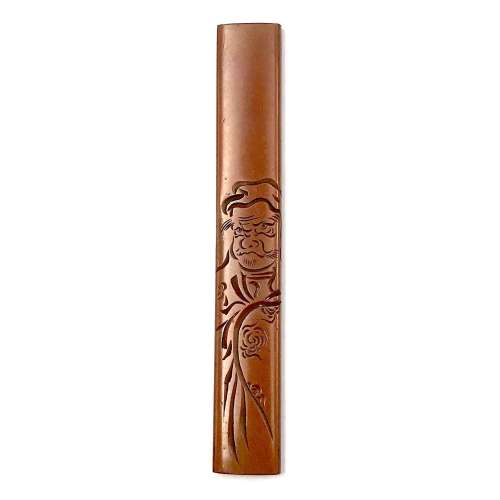 Kozuka made of pure copper with Daruma motif. The engraving technique is known as katakibori ("half-cut carving"). Signed on the back: Yasuchika. Size: 96.5 (H) x 14.5 mm (W). Edo period (Late 18th century). The technique of Katakiribori was developed by Yokoya school of artisans. Detailed account of Yasuchika family of kodōgo carvers is given at Japanese Sword Fittings from the Alexander G. Mosle Collection; Sebastian Izzard LLC, 2004 on page 64. The article ends with the following statement: "Given the popularity of his style and his many students, it is not surprising that a number of works bearing Yasuchika's signature are today disputed." S. Izzard attributes Yasuchika masters to Nara school. Yasuchika-signed kozuka in Important Japanese Swords and Sword Furniture and Works of Art [November 5, 1980, sales "Kotetsu". New York, Christie, Manson & Woods International Inc., 1980, pp.92-93, lot 172 and 173] are stylistically very different to our example. A shibuichi katakiribori kozuka, bearing the signature of Yashuchika, is illustrated at The Hartman Collection of Japanese Metalwork [sold at auction by Christie, Manson & Woods Ltd. June 30 and July 1, London, 1976] on page 82, lot 291. It depicts Daikoku and stylistically similar to ours. The description on page 83 says: "signed Yasuchika, and inscribed "drawn by Hanabusa Itcho" (Yasuchika IV, school of Iawamoto konkan, circa 1800)". A detailed account of Yasuchika signatures is presented at Masterpiece tsuba and kodogu from the Hans Conried and Alexander G. Mosle collections. Important woodblock prints by Utamaro, Hokusai, Hiroshige, Yoshida and other masters. San Francisco, September 1-25, 1983. Catalog #7. Robert E. Haynes, Ltd., pp. 141-174. The example that looks like ours is on page 146:
Kozuka made of pure copper with Daruma motif. The engraving technique is known as katakibori ("half-cut carving"). Signed on the back: Yasuchika. Size: 96.5 (H) x 14.5 mm (W). Edo period (Late 18th century). The technique of Katakiribori was developed by Yokoya school of artisans. Detailed account of Yasuchika family of kodōgo carvers is given at Japanese Sword Fittings from the Alexander G. Mosle Collection; Sebastian Izzard LLC, 2004 on page 64. The article ends with the following statement: "Given the popularity of his style and his many students, it is not surprising that a number of works bearing Yasuchika's signature are today disputed." S. Izzard attributes Yasuchika masters to Nara school. Yasuchika-signed kozuka in Important Japanese Swords and Sword Furniture and Works of Art [November 5, 1980, sales "Kotetsu". New York, Christie, Manson & Woods International Inc., 1980, pp.92-93, lot 172 and 173] are stylistically very different to our example. A shibuichi katakiribori kozuka, bearing the signature of Yashuchika, is illustrated at The Hartman Collection of Japanese Metalwork [sold at auction by Christie, Manson & Woods Ltd. June 30 and July 1, London, 1976] on page 82, lot 291. It depicts Daikoku and stylistically similar to ours. The description on page 83 says: "signed Yasuchika, and inscribed "drawn by Hanabusa Itcho" (Yasuchika IV, school of Iawamoto konkan, circa 1800)". A detailed account of Yasuchika signatures is presented at Masterpiece tsuba and kodogu from the Hans Conried and Alexander G. Mosle collections. Important woodblock prints by Utamaro, Hokusai, Hiroshige, Yoshida and other masters. San Francisco, September 1-25, 1983. Catalog #7. Robert E. Haynes, Ltd., pp. 141-174. The example that looks like ours is on page 146:
 Though we have to admit that the example from Catalog #7 by Robert E. Haynes looks much stronger.
Though we have to admit that the example from Catalog #7 by Robert E. Haynes looks much stronger.
-
 A pair of copper menuki in the form of a shrimp (lobster, crawfish, ebi) with eyes inlaid in shakudō.
A pair of copper menuki in the form of a shrimp (lobster, crawfish, ebi) with eyes inlaid in shakudō.Length: 58.2 mm.
-
 Copper (suaka) tsuba of oval form carved in relief, pierced and inlaid with soft metals (gold, shakudō, shibuichi or silver) with a cormorant fisherman (ushō) and moon motif on the face and a boat among the bank reeds on the reverse. Signed: Nagatsune. Box inscription: Tsuba with cormorant fishing, made by Nagatsune. Dimensions: 62.7 mm x 53.2 mm x 4.2 mm (at seppa-dai) Edo period: 18th century. Nagatsune (1721-1787), 1st generation master of Inchinomiya School in Kyoto, adopted son of the gilder Nagayoshi, student of Yasui Takanaga [M. Sesko 'Genealogies', p. 26]. Detailed account of the school is given at The Japanese toso-kinko Schools.// Lulu Inc., 2012 by Markus Sesko, pp. 104-108. Nagatsune's biographical sketch can be found there on pp. 104-106. "What Sōminis in the East (Edo), Nagatsune is in the West (Kyōto)." “Since Nara period, Japanese fishermen in small boats have used cormorants (u) to catch river fish at night, binding the necks of the birds so that the fish are not swallowed. […] The bird and the work it performs are symbols of selfless devotion to one’s master and keen eyesight.” – from Merrily Baird 'Symbols of Japan. Thematic motifs in art and design.' //Rizzoli international publications, Inc., 2001; p. 104. See also in this collection: TSU-241 and TSU-0096
Copper (suaka) tsuba of oval form carved in relief, pierced and inlaid with soft metals (gold, shakudō, shibuichi or silver) with a cormorant fisherman (ushō) and moon motif on the face and a boat among the bank reeds on the reverse. Signed: Nagatsune. Box inscription: Tsuba with cormorant fishing, made by Nagatsune. Dimensions: 62.7 mm x 53.2 mm x 4.2 mm (at seppa-dai) Edo period: 18th century. Nagatsune (1721-1787), 1st generation master of Inchinomiya School in Kyoto, adopted son of the gilder Nagayoshi, student of Yasui Takanaga [M. Sesko 'Genealogies', p. 26]. Detailed account of the school is given at The Japanese toso-kinko Schools.// Lulu Inc., 2012 by Markus Sesko, pp. 104-108. Nagatsune's biographical sketch can be found there on pp. 104-106. "What Sōminis in the East (Edo), Nagatsune is in the West (Kyōto)." “Since Nara period, Japanese fishermen in small boats have used cormorants (u) to catch river fish at night, binding the necks of the birds so that the fish are not swallowed. […] The bird and the work it performs are symbols of selfless devotion to one’s master and keen eyesight.” – from Merrily Baird 'Symbols of Japan. Thematic motifs in art and design.' //Rizzoli international publications, Inc., 2001; p. 104. See also in this collection: TSU-241 and TSU-0096The design was popular among the tsuba makers. We find one in the Alexander G. Moslé collection [Japanese Sword Fittings from the Alexander G. Moslé Collection; Sebastian Izzard LLC, 2004, page 90, №123] signed Nagatsune with kaō: Tsuba with cormorant fisherman, moon, and boat. Squared-oval shibuichi plate, slightly raised rim, engraved, pierced, and inlaid with soft metals in relief. 6.7 x 5.8 cm.

Alexander G. Moslé collection №123.
Another reference: Lundgren Collection, 1990, page 86 №207: Sword guard with design of ushō (person who fishes with cormorants). Signed by Nagatsune. Ichinomiya school. 6.45 x 5.95 x 0.40 cm. Polished shibuichi taka-bori relief, gold and silver inlay. Edo period, 18th century.

Lundgren Collection №207:
-

Copper tsuba of slightly elongated round form carved in low relief (usuniku-bori, katakiri bori) with the design of a mythical creature: a horse, however, with divided hoofs, with anthropomorphic (human-like) face though with a vertically positioned third eye on the forehead, and a corn. Certain elements of the image accentuated with gold iroe. On the back: flowers and grasses carved in katakiribori technique. Shakudō fukurin.
Edo period.
Dimensions: 70.7 x 70.2 x 3.7 mm In a custom wooden box. -

A copper tsuba with ishime-ji ground carved and polished (migaki-ji) with sitting Daruma; his eyes are inlaid with shakudo and he has a golden earring. The reverse carved with four characters: 廓 然 無 性 (Kakunen-mushō). It is a Zen proverb that goes back to Bodhidharma (Daruma), meaning "boundless expanse and nothing that can be called holy." [Markus Sesko translation]. Shakudo fukurin.
Unsigned.
Edo period (circa 1800). Dimensions: 68.2 x 65.5 x 4.8 (center) x 3.2 (rim) mm -

Fuchi-kashira made of shakudō carved and inlaid with gold and red copper with the design of a bat and a fruit (persimmon?). Nanako surface.
Fuchi: 37 x 19 x 7 mm. Kashira: 34 x 16 x 5 mm. Main material: shakudō. Other metals: gold and copper. Surface treatment: nanako-ji. -
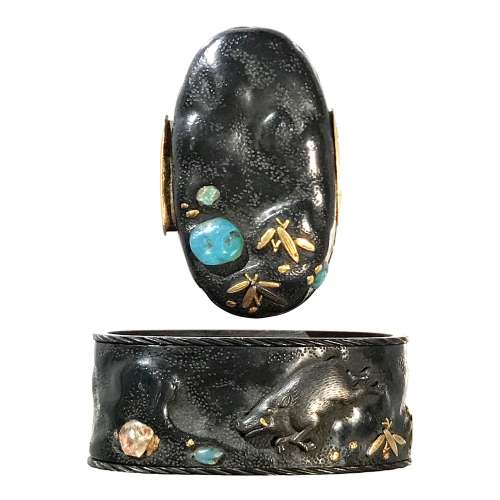 Signature: Unsigned
Signature: UnsignedFuchi-kashira with rock and boar (iwa ni inoshishi zu) motif. Inlay of precious stones or colour glass. Shakudō, gold, gemstones. Technique: Sukibori zogan kiniroe.
Fuchi: 36 x 21 x 14 mm; Weight: 22 g; Kashira: 32 x 17 x 5 mm; Weight: 8 g; Material : Shakudō; Gold; Gemstones (Chalcedony and Rose Quartz). Possibly, Owari school. -

Fuchi-kashira made of Shibuichi carved and inlaid with shakudō, gold, silver, and copper with the design of spider holding a fly on the fuchi, and other insects (ant-lion, wasp, and ant) on the kashira.
Fuchi: 35.1 mm. Kashira: 38.7 mm. Main material: Shibuichi. Other metals: shakudō, gold, silver, and copper. Decorative technique: iroe taka-zōgan. -
 Fuchi: 38 x 22 x 12 mm. Kashira: 32 x 17 x 11 mm Main material: shakudo; surface treatment: nanako-ji; other metals: gold, shibuichi and copper; decorative technique: iroe takazogan. Signed: Nyudo Jounishi 人道 乗西 (possibly)
Fuchi: 38 x 22 x 12 mm. Kashira: 32 x 17 x 11 mm Main material: shakudo; surface treatment: nanako-ji; other metals: gold, shibuichi and copper; decorative technique: iroe takazogan. Signed: Nyudo Jounishi 人道 乗西 (possibly) -
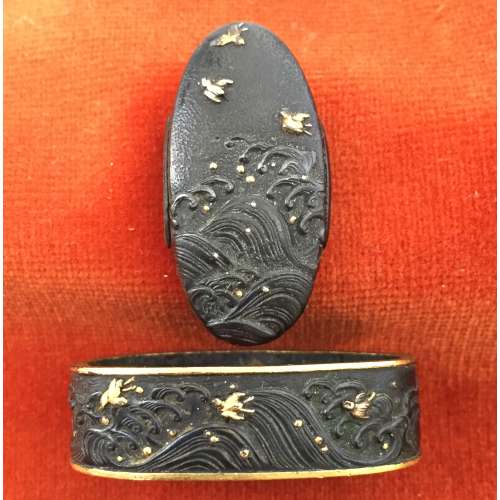 Fuchi: 37 x 21 x 11 mm; Weight: 13 g Kashira: 34 x 16 x 6 mm ; Weight: 10 g Material : Shakudo; Gold. Signature: Unsigned Technique: Sunameji Sukibori Zogan Decoration: Nami Chidori zu (wave & plover)
Fuchi: 37 x 21 x 11 mm; Weight: 13 g Kashira: 34 x 16 x 6 mm ; Weight: 10 g Material : Shakudo; Gold. Signature: Unsigned Technique: Sunameji Sukibori Zogan Decoration: Nami Chidori zu (wave & plover) -
 Fuchi: 38 x 22 x 14 mm. Kashira: 33 x 18 x 9 mm Techniques: Usu-shishiai-bori (薄肉合彫) – low-relief, zogan.
Fuchi: 38 x 22 x 14 mm. Kashira: 33 x 18 x 9 mm Techniques: Usu-shishiai-bori (薄肉合彫) – low-relief, zogan. -
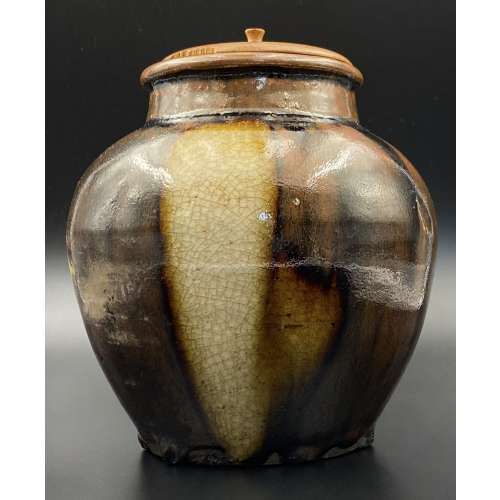 Seller's description: "pottery jar presenting a circular, concave base, an apple-form body, a cylindrical neck, and an annular flared rim. Boasting a lustrous burnish, the gorgeous vessel displays three narrow vertical panels in a hue of cream over mottled shades of chocolate brown and mocha on its body and a caramel-coloured neck and rim. The discoid lid features a lovely natural woodgrain surface incised with three decorative concentric circles around a petite knob-like handle. Note the beautiful globules of glaze that decorate the periphery of the base! This type of vessel is known as Seto ware." Size: Dia: 13 cm, H: 14 cm.
Seller's description: "pottery jar presenting a circular, concave base, an apple-form body, a cylindrical neck, and an annular flared rim. Boasting a lustrous burnish, the gorgeous vessel displays three narrow vertical panels in a hue of cream over mottled shades of chocolate brown and mocha on its body and a caramel-coloured neck and rim. The discoid lid features a lovely natural woodgrain surface incised with three decorative concentric circles around a petite knob-like handle. Note the beautiful globules of glaze that decorate the periphery of the base! This type of vessel is known as Seto ware." Size: Dia: 13 cm, H: 14 cm. -
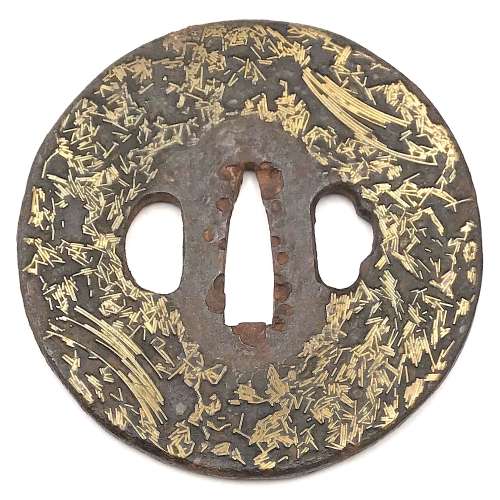 Gomoku-zōgan tsuba. Iron, inlaid with brass scrap (gomoku-zōgan), and polished. Height: 75.3 mm; Width 74.9 mm; Thickness at seppa-dai: 3.6 mm. Weight 130.2 g. Edo, 18th century. Gary D. Murtha dedicates 10 pages to this type of tsuba: "...they were made by soldering brass overlay scraps to the iron plate". Actual gomoku-zōgan tsuba are seldom found in collections most likely because they have little if any artistic attributes. In addition, many have rough surfaces making them questionable for use on a sword. It is said that many of these were produced in Yokohama for export to the West during the late Edo period". G. D. Murtha then describes the technique of making gomoku-zōgan in every detail, and states that "The brass pieces are said to represent 'fallen pine needles', a description most likely created to add aesthetic value to help market the tsuba" [see:Gary D. Murtha. Japanese sword guards. Onin - Heianjo - Yoshiro. GDM Publications, 2016; pp. 160-161].
Gomoku-zōgan tsuba. Iron, inlaid with brass scrap (gomoku-zōgan), and polished. Height: 75.3 mm; Width 74.9 mm; Thickness at seppa-dai: 3.6 mm. Weight 130.2 g. Edo, 18th century. Gary D. Murtha dedicates 10 pages to this type of tsuba: "...they were made by soldering brass overlay scraps to the iron plate". Actual gomoku-zōgan tsuba are seldom found in collections most likely because they have little if any artistic attributes. In addition, many have rough surfaces making them questionable for use on a sword. It is said that many of these were produced in Yokohama for export to the West during the late Edo period". G. D. Murtha then describes the technique of making gomoku-zōgan in every detail, and states that "The brass pieces are said to represent 'fallen pine needles', a description most likely created to add aesthetic value to help market the tsuba" [see:Gary D. Murtha. Japanese sword guards. Onin - Heianjo - Yoshiro. GDM Publications, 2016; pp. 160-161]. -
 This print was sold to me with the following description: "Ikkansai EISHO (Fl. early 19th c.). A portrait of the wrestler Kuroyanagi Matsujiro, ring name Kumagatake Inosuke. Eisho was a pupil of Eishi. Published c. 1820s by Uoya Eikichi. Signed Shunsai Eisho ga." As a result of our joint effort with my beloved sister, we have so far found the following: The artis is mentioned in The Hotei Encyclopedia of Japanese Woodblock Prints, 2005, Vol 2; p. 438 under the name of Harukawa Eichō. From this source we learned that the artist was active from about 1818 till 1844, and was a print designer in Kyoto. He was a student first of Harukawa Goshichi and later studied in Edo (Tokyo) with Keisai Eisen, when he assumed the art name 'Eichō'. Other names: Shunsai. The Japanese web page dedicated to Harukawa Eichō provides more details: The artist lived from the 4th year of Tenmei ( 1784 ) to the first year of Kaei ( 1848 ). He was a student of Harukawa Goshichi, Kikukawa Eizan as well as of Keisai Eisen. His popular name was Kamenosuke. He was from Kyoto. He took "gagō" (artistic names) of Eishō when he was a student of Harukawa Goshichi; later, when he became a student of Kikukawa Eizan and Keisai Eisen he took the name of Kikukawa Eichō. The artist was mostly known for his bijinga (beautiful women) prints as well as kanazōshi illustrations. Nothing is said anywhere about his sumo prints, though the reference to another Kyushu sumo wrestler portrait has been found. The sumo wrestler Kuroyanagi Matsujiro is also a somewhat obscure figure: information about his life and career is quite inconsistent. It may so happened that two different persons were combined together. Wikipedia page about Aoi Aso Jinja, a Shinto shrine in Hitoyoshi in Kumamoto prefecture, tells us the following:This information has some inconsistencies already. If our hero was born in 1807 and promoted to ōzeki at the age of 32, it should have been the year 1839, not 1847. I found Kumagatake Isuke at "Sumo Reference" website:
This print was sold to me with the following description: "Ikkansai EISHO (Fl. early 19th c.). A portrait of the wrestler Kuroyanagi Matsujiro, ring name Kumagatake Inosuke. Eisho was a pupil of Eishi. Published c. 1820s by Uoya Eikichi. Signed Shunsai Eisho ga." As a result of our joint effort with my beloved sister, we have so far found the following: The artis is mentioned in The Hotei Encyclopedia of Japanese Woodblock Prints, 2005, Vol 2; p. 438 under the name of Harukawa Eichō. From this source we learned that the artist was active from about 1818 till 1844, and was a print designer in Kyoto. He was a student first of Harukawa Goshichi and later studied in Edo (Tokyo) with Keisai Eisen, when he assumed the art name 'Eichō'. Other names: Shunsai. The Japanese web page dedicated to Harukawa Eichō provides more details: The artist lived from the 4th year of Tenmei ( 1784 ) to the first year of Kaei ( 1848 ). He was a student of Harukawa Goshichi, Kikukawa Eizan as well as of Keisai Eisen. His popular name was Kamenosuke. He was from Kyoto. He took "gagō" (artistic names) of Eishō when he was a student of Harukawa Goshichi; later, when he became a student of Kikukawa Eizan and Keisai Eisen he took the name of Kikukawa Eichō. The artist was mostly known for his bijinga (beautiful women) prints as well as kanazōshi illustrations. Nothing is said anywhere about his sumo prints, though the reference to another Kyushu sumo wrestler portrait has been found. The sumo wrestler Kuroyanagi Matsujiro is also a somewhat obscure figure: information about his life and career is quite inconsistent. It may so happened that two different persons were combined together. Wikipedia page about Aoi Aso Jinja, a Shinto shrine in Hitoyoshi in Kumamoto prefecture, tells us the following:This information has some inconsistencies already. If our hero was born in 1807 and promoted to ōzeki at the age of 32, it should have been the year 1839, not 1847. I found Kumagatake Isuke at "Sumo Reference" website:Kuroki Matsujiro (黒木松次郎) was born in the village of Itsuki in Kuma district, Kumamoto prefecture, island of Kyushu in Bunka era, 4th year (1807). Since from his childhood he was blessed by great physique and tough strength. He had affection for sumo. At the age of 18 he became a sumo student of Kumamoto Shimakawa Ikuhei and took the name of Toyama Hidekichi (遠山日出吉). At the age of 23 (1830), he entered sumo stables in Kyoto, mastered the art of taming of young horses, and his talents improved. At the age of 31 he went to Edo, and became a disciple of the ōzeki Oitekaze Kitaro of Hirado domain in Hizen province, also from Kyushu island. After that, he changed his name and became Kuroyanagi Matsujiro (黒柳松次郎 – as on the print). In 1847 (Bunka era, 4th year) he distinguished himself by advancing to the first grade, and at the age of 32 he was promoted to ozeki level, becoming sekitori. After changing his name to Kuma-ga-take Inosuke (熊ヶ嶽猪之介 / くまがたけいのすけ) he displayed further efforts, and became one of the strongmen that fermented sumo wrestling in Edo. In 1853 (Kaei era, 6th year) he retired and returned to his village, becoming an employee as a strongman of Sagara domain (相良藩), and worked hard as instructor of the sumo training hall to train successors until 1855 (Ansei era, 2nd year) when he passed away at the age of 48. Even today Kuma-ga-take's home exists in Itsukimura (his native village). Also, on those grounds a descendant of Kuma-ga-take runs minshuku (guest house) that bears the name of "The Kuroki Pension (lodging) ", and tourists come to visit from various parts of Japan. In 2015, tenth month, within the borders of Aoi Aso Shrine there was built a gravestone publicly honoring Kuma-ga-take Inosuke, sumo wrestler from Edo / of Edo period.
The real name is the same, the ring name Kuroyanagi Matsujiro is the same, however, the date of birth here is 1815. He fought from 1836 till 1853 - which is quite similar to "At the age of 31 he went to Edo, and became a disciple of the ōzeki Oitekaze Kitaro". Though, in 1836 he might be 29 years old. His bouts are listed from spring 1841 to spring 1848 under the name of Kuroyanagi and from winter 1848 till spring 1853 he listed under the name of Kumagatake Isuke [Inosuke].Highest Rank Maegashira 4 Real Name Kuroki Birth Date 1815 Shusshin Kumamoto-ken, Kuma-gun Death Date March 6, 1855 (40 years) Heya Oitekaze Shikona Kuroyanagi Matsujiro - Kumagatake Isuke Hatsu Dohyo 1836.02 (Sandanme) Intai 1853.02 On another important sumo history website, I found that Kuroyanagi first appeared at ring in the spring of 1823 (he might have been 16 years old then, which does not seem right). Then, in the winter tournament of 1848 Kuroyanagi took the name Kumagatake. At the spring tournament of 1853 Kumagatake (Kuroyanagi) retired. This is quite consistent so far.
Then, I found Oitekaze Kitaro, allegedly the teacher of Kuroyanagi.
Everything look good with an exception of ring names (shikona): Kuroyanagi Matsujiro (1823-1828) - Kuroyanagi Sumiemon (1829-30) - Oitekaze Kitaro (1831-1839). May it be that Sato Matsutaro fought under the name of Kuroyanagi Matsujiro until Kuroki Matsujiro took this name from his master? I don't have another explanation of the enigma. What we know is that we have a portrait of a sumo wrestler called Kuroyanagi Matsujiro from Kyushu, but we don't know whether this was the one from Kumamoto (Kumagatake Inosuke, 1807/1815-1855) or the other from Kanagawa (Oitekaze Kitaro, 1799-1865). Subsequently, we may declare that the artist is Shunsai Eishō, a.k.a.Harukawa Eichō from Eishi school (The Hotei Encyclodepdia, p. 524), we can date the print from 1818 to 1844, and only tell that the wrestler is Kuroyanagi Matsujiro from Kyushu (either Kumagatake Inosuke or Oitekaze Kitaro). The publisher of the print is Moriya Jihei (Marks №353, p. 243-5). That's it.Highest Rank Ozeki Real Name SATO Matsujiro (Matsutaro#) Birth Date 1799 Shusshin Kanagawa-ken, Tsukui-gun Death Date May 4, 1865 (66 years) Heya Oitekaze Shikona Kuroyanagi Matsujiro - Kuroyanagi Sumiemon - Oitekaze Kitaro Hatsu Dohyo 1817.10 (Jonokuchi) Intai 1839.03 -
 Iron tsuba of oval form with design of cherry blossoms in positive and negative silhouette openwork (ji-sukashi and in-sukashi). Details chiseled in kebori technique. Rounded rim. Copper sekigane. Higo school, Hayashi sub-school. Unsigned. Attributed to third generation Tōhachi (1723-1791). Edo period, 18th century (Hōreki / Meiwa era: 1751-1772). Height: 78.7 mm. Width: 72.2 mm. Rim thickness: 5.2 mm. Center thickness: 5.2 mm. Provenance: Sasano Masayuki Collection, № 289: "Hayashi. Third generation Tohachi (died in in the third year of Kansei, 1791 at the age of sixty-nine). Early 18th century (Hohreki / Meiwa era). "
Iron tsuba of oval form with design of cherry blossoms in positive and negative silhouette openwork (ji-sukashi and in-sukashi). Details chiseled in kebori technique. Rounded rim. Copper sekigane. Higo school, Hayashi sub-school. Unsigned. Attributed to third generation Tōhachi (1723-1791). Edo period, 18th century (Hōreki / Meiwa era: 1751-1772). Height: 78.7 mm. Width: 72.2 mm. Rim thickness: 5.2 mm. Center thickness: 5.2 mm. Provenance: Sasano Masayuki Collection, № 289: "Hayashi. Third generation Tohachi (died in in the third year of Kansei, 1791 at the age of sixty-nine). Early 18th century (Hohreki / Meiwa era). " -
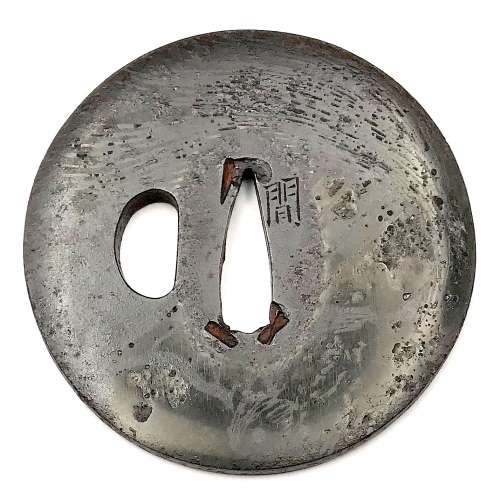 Iron tsuba of round form (width > height) decorated with a squirrel (on the face) and bamboo (on the reverse) motif in sahari flat inlay (hira-zōgan). Signed: Hazama (間) Size: 75.1mm x 75.9mm, thickness of seppa-dai 5.4mm. Early 18th century, mid Edo. Haynes/Torigoye: "There is another name for Hazama tsuba: the Kameyama school. In the period from Hōei to Kyōhō (1704-36) at Kameyama, in the province of Ise, the Kunitomo family made this style of tsuba" [...] The two artists who are best known for the sahari style of inlaid tsuba are Sadahide and Masahide" [...] The signature Hazama should be considered as that of Masahide". Sahari inlay is the distinctive characteristics of Hazama school. Sahari is an alloy of copper, tin, lead, zinc and silver. Hazama tsuba was carved patterns at first, then poured heated into the carvings on iron ground. Because it is an alloy, sahari shows different colors in each tsuba. According to Merrily Baird [Symbols, p. 163], "squirrels (risu) ... have no symbolic importance". NBTHK certificate №448388.
Iron tsuba of round form (width > height) decorated with a squirrel (on the face) and bamboo (on the reverse) motif in sahari flat inlay (hira-zōgan). Signed: Hazama (間) Size: 75.1mm x 75.9mm, thickness of seppa-dai 5.4mm. Early 18th century, mid Edo. Haynes/Torigoye: "There is another name for Hazama tsuba: the Kameyama school. In the period from Hōei to Kyōhō (1704-36) at Kameyama, in the province of Ise, the Kunitomo family made this style of tsuba" [...] The two artists who are best known for the sahari style of inlaid tsuba are Sadahide and Masahide" [...] The signature Hazama should be considered as that of Masahide". Sahari inlay is the distinctive characteristics of Hazama school. Sahari is an alloy of copper, tin, lead, zinc and silver. Hazama tsuba was carved patterns at first, then poured heated into the carvings on iron ground. Because it is an alloy, sahari shows different colors in each tsuba. According to Merrily Baird [Symbols, p. 163], "squirrels (risu) ... have no symbolic importance". NBTHK certificate №448388. -
 Iron tsuba of a spindle shape (tate-itomaki-gata) pierced and inlaid in brass suemon-zōgan with bellflowers, vines and foliage, and a dragonfly in the upper right corner, on both sides. One of the hitsu-ana plugged with grey metal (led or pewter), nakaga-ana fitted with copper sekigane. The shape of the tsuba may be interpreted as four saddles connected to each other by horse bits. Such a design of sukashi and zōgan is usually attributed to Kaga Yoshirō branch of Heianjo school, active in the second half of the 17th century (c. 1650-1700). Size: 95.9 mm diagonal; 4.1 mm thickness. Tokubetsu Kicho certificate № 332 issued by NBTHK on October 12, 1965.
Iron tsuba of a spindle shape (tate-itomaki-gata) pierced and inlaid in brass suemon-zōgan with bellflowers, vines and foliage, and a dragonfly in the upper right corner, on both sides. One of the hitsu-ana plugged with grey metal (led or pewter), nakaga-ana fitted with copper sekigane. The shape of the tsuba may be interpreted as four saddles connected to each other by horse bits. Such a design of sukashi and zōgan is usually attributed to Kaga Yoshirō branch of Heianjo school, active in the second half of the 17th century (c. 1650-1700). Size: 95.9 mm diagonal; 4.1 mm thickness. Tokubetsu Kicho certificate № 332 issued by NBTHK on October 12, 1965. -
 Iron tsuba decorated with sparrows and bamboo inlaid and chiseled in yellow brass, with snow lying on bamboo leaves inlaid in silver-ish shibuichi. Copper sekigane. The kogai-hitsu-ana probably cut out at a later date. Heianjō school. Unsigned. Height: 86.0 mm, Width: 85.4 mm, Thickness at seppa-dai: 2.9 mm. Momoyama or early Edo period, first half of the 17th century. Merrily Baird, Symbols..., page 118: "The association of the sparrow (suzume) with both bamboo and rice heads is an old one found in Japanese poetry, paining, and design."
Iron tsuba decorated with sparrows and bamboo inlaid and chiseled in yellow brass, with snow lying on bamboo leaves inlaid in silver-ish shibuichi. Copper sekigane. The kogai-hitsu-ana probably cut out at a later date. Heianjō school. Unsigned. Height: 86.0 mm, Width: 85.4 mm, Thickness at seppa-dai: 2.9 mm. Momoyama or early Edo period, first half of the 17th century. Merrily Baird, Symbols..., page 118: "The association of the sparrow (suzume) with both bamboo and rice heads is an old one found in Japanese poetry, paining, and design." -
 Iron tsuba of almost round form with a brass outlined circular opening (sukashi) in the bottom adorned with the Myriad Treasures [takaramono, 宝物] and winter motifs inlaid in cast brass (suemon-zōgan); hitsu-ana possibly cut later, both plugged with shakudo, nakaga-ana fitted with copper sekigane. According to Merrily Baird*) (2001), the symbolism of Myriad Treasures “is associated with the Seven Gods of Good Luck, who carry them in a sack”. Among the treasures, which are said to ensure prosperity, long life, and general good fortunes, are (reading clockwise from the top):
Iron tsuba of almost round form with a brass outlined circular opening (sukashi) in the bottom adorned with the Myriad Treasures [takaramono, 宝物] and winter motifs inlaid in cast brass (suemon-zōgan); hitsu-ana possibly cut later, both plugged with shakudo, nakaga-ana fitted with copper sekigane. According to Merrily Baird*) (2001), the symbolism of Myriad Treasures “is associated with the Seven Gods of Good Luck, who carry them in a sack”. Among the treasures, which are said to ensure prosperity, long life, and general good fortunes, are (reading clockwise from the top):- Sake set [shuki, 酒器], namely flask, ladle, and cups
- Cloves [choji, 丁子]
- Purse of inexhaustible reaches [kinchaku, 巾着]
- Magic mallet [kozuchi, 小槌]
- Key to the storehouse of the Gods [kagi, 鍵]
- Rhombus, or Lozenge (hosho, 方勝), with the second ideograph meaning victory.
- Sacred (or wish-granting) gem, or jewel [hōju, 宝珠]
- Hats of invisibility [kakuregasa, 隠れ笠]
-

Tsuba of oval form decorated with vines, tendrils, and leaves on trellis in brass inlay with details carved in kebori, and pierced with six family crests (mon) with two, three and four pointing stars in openwork, each outlined with brass wire and carved in kebori. Original hitsu-ana outlined with brass wire was probably enlarged later. Copper sekigane.
Momoyama to early Edo period (end of the 16th - beginning of the 17th century). Dimensions: 68.3 x 64.5 x 3.4 mm. -

Iron tsuba of round form (tsurumaru) decorated with a design of crane and pines, or "nesting crane (sugomori-tsuru)" in openwork (sukashi). Details carved in kebori. Rounded rim.
Size: 74.7 x 69.8 x 4.8 mm.
Unsigned.
Edo period, ca. 17th century.
NBTHK Certificate № 463485. The certificate says it's a Higo School piece. The design was popular in both Akasaka and Higo schools. The Akasaka example: at Kodogu and tsuba. International collections not published in my books. (Toso Soran). Ph. D. Kazutaro Torigoye, 1978, p. 246: "Late Edo. Jiyūgata. Sined: Akasaka Tadanori saku."The Higo example can be found at Iron tsuba. The works of the exhibition "Kurogane no hana", The Japanese Sword Museum, 2014, p. 69, №56: Sugomori-tsuru sukashi-tsuba (Nesting Carne). Mumei: Matashichi (1st generation), early 17th century.
Torigoye, 1978, p. 246. Late Akasaka.

Kurogane no hana, 2014, p. 69, №56. Higo tsuba.


